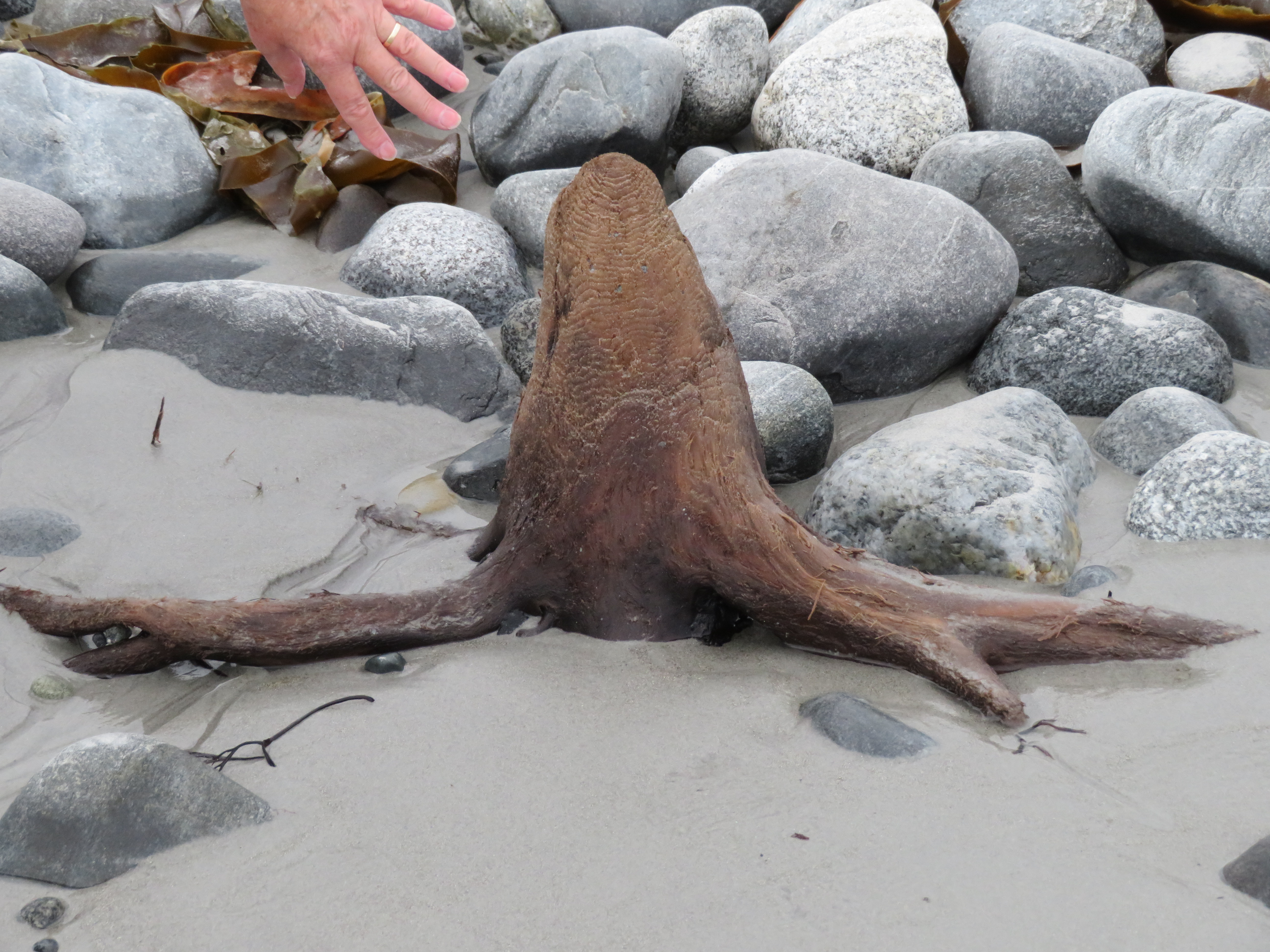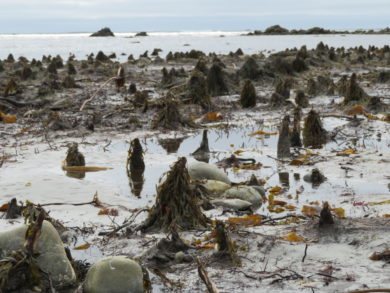One of the most delightful aspects of travel is the prospect of new adventures. And so it was, on a blustery and chilly day in late September, that we found ourselves driving along the southeast coast of Nova Scotia. We were heading to Hawk Beach on Cape Sable Island, the most southerly tip of Nova Scotia. Such beaches are never easy to find, and we had to ask twice before we found it. After driving down very obscure roads, we found the beach after we had scrambled up quite a high embankment.
It was low tide. There before us the white sandy beach was littered with rocks, and farther out towards the water, an army of dark brown projections, each about 55 cm (18 inches) or more, tall, poked up from the shore. There were hundreds of them, and farther along the beach there were thousands more. This was one of the famous “drowned forests” of the Maritimes. Upon closer examination, we discovered that each of these objects was a tree trunk partially worn away by the sea. Many were about 25 cm (10 inches) or more in diameter. Many had long branched roots extending from the white sand or darkish sediment. The wood looked like real wood though some people say there are some petrified specimens.
Apparently at high tide this drowned forest lies under more than 3 metres of sea water. Yet the forest gives every indication of having grown where it now stands. Literature about the location suggests that the forest might be 1500 years old and that as the shore sank years ago, the sea invaded and took over the forest. Nobody really knows, of course.
Three thoughts race through our minds as we snap picture after picture of this remarkable scene. Firstly, these wooden stumps (probably of a conifer tree) have been worn down to such short objects as the sea with sand invaded their space. Secondly, of course, it was amazing how lengthy roots were still attached to some of them. And thirdly, all the stumps appeared to be positioned at the same level, a true in situ forest.
Wow!! The contrast with some other Nova Scotia beaches could scarcely be more marked. One has only to think about Joggins which is much farther west, near Parssboro. Joggins is now a UNESCO world heritage site. As the sea works relentless on the rocky cliff by the shore, 5 m tall tree trunks are exposed extending vertically through numerous strata of sedimentary rock. These lycopod (club moss) trunks, composed initially not of woody tissue but of something softer, were actually tall trees. They have been buried by shelly limestone, shale and sandy sediments which have turned to rock. So have the tree trunks.
Unlike the drowned forest at Hawk Beach, here at Joggins, the trunks are found at different levels in the cliff. Some trunks have roots still attached at their lower end. Various scientists have speculated that these trees represent successive forests which were gradually buried by sediments that accumulated over long geological ages. However when we compare this beach with Hawk Beach, we see that these hollow soft trunks could never have stood for long while sediments accumulated around their bases. It is evident that the Joggins forest did not grow where we now see it, but was swept up from elsewhere and buried all at once in a massive onslaught of water and sediment. Instead of a long slow burial process, the Joggins trees were buried catastrophically by amazing flood waters.
By the way, based on the fact that these Lepidodendron trees are extinct, and a major component of some coal beds, the Joggins fossils are said to have been part of a Carboniferous community, estimated to be 300 million years older than the Hawk Beach forest. But the estimated time interval is based on a number of assumptions such as how slowly the sediments accumulated. And we know the sediments came down quickly here!
Farther north in Nova Scotia on the Northumberland Strait Coast, on the beach at Brule (near Tatamagouche) another drowned forest has been discovered. Here too, the trees are encased in rock and are themselves also fossilized. This is the only standing forest of Walchia (an extinct conifer something like Norfolk Island pine). Similar trees grow in Australia today. In the deeply cracked rock lie stumps still in vertical position as well as tree trunks which lie prostrate in the rock. Imprints of foliage can also be found in the rock. Like Hawk Beach forest, this one appears to have been buried where it grew (in situ). However unlike Hawk Beach, the Brule forest appears to have been overcome by a sudden catastrophe that buried the whole community at once. There were also animals living in this community. The trackways of tiny lizards and large sail-backs proceed (for each species) all in the same direction. Based partly on the nature of the fossils, scientists suggest that these creatures lived somewhat after the Joggins community, now entombed in rocks they call lower Permian.
Obviously the fate of the modern drowned forest at Hawk Beach demonstrates how continuous exposure to the sea leads to tree remains that have been seriously worn away. The fossilized tree trunks, on the other hand, only have lasted because they were catastrophically entombed in sediments carried by raging flood waters.
Is it not good to discover new places which encourage research and thinking on our part? Now where should we go next?
For more in-depth information on maritime beaches see:
www.create.ab.ca/maritime-dinosaurs-and-other-fun-fossils
Moxie
January 2020
Subscribe to Dialogue








